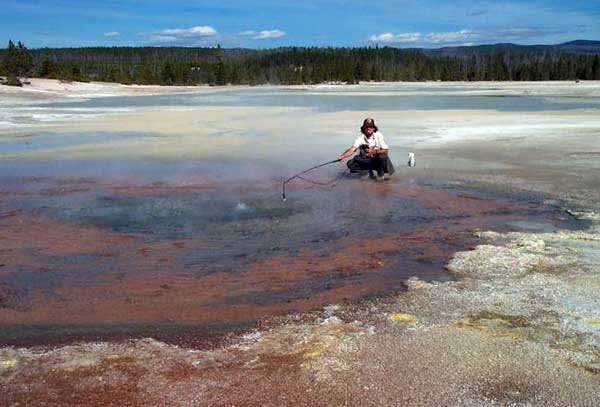
Researchers have used detailed genetic analyses to identify novel microbes found in the Norris Geyser Basin of Yellowstone National Park. (YNP photo)
By Ruffin Prevost
Researchers are continuing to find new and unique properties in the thermal features of Yellowstone National Park, with a recent study suggesting that novel microbes found in the Norris Geyser Basin might someday help in unlocking more environmentally friendly forms of energy.
Detailed and complex genetic analyses carried out by scientists from Montana State University and other laboratories have yielded what appears to be a new phylum of archaea — a new branch on the tree of life that could lead to new methods of carbon sequestration or producing biofuels.
The scientists studied DNA extracted from microbial mats in the One Hundred Spring Plain, according to a statement released by the Pacific Northwest National Laboratory, a U.S. Department of Energy research facility involved in the study.
The genetic analysis focused on microbes that thrive in extremely hot waters and that produce iron oxide—or rust, in simple form—as a byproduct of extracting energy from their environment.
“Previous studies of acidic ferric ion mats from Yellowstone had shown a remarkable diversity of uncultivated, undescribed archaea,” said Bill Inskeep, a professor of geomicrobiologyat Montana State University.
“One of our goals was to identify and describe novel thermophilic—requiring high temperature—archaea inhabiting acidic iron-oxide microbial mats,” in Yellowstone, Inskeep said.
The microbial mats in the Norris Geyser Basin are chemotrophic, generating energy by oxidizing electron donors present in Yellowstone’s geothermal waters, according to the study. The novel microbes also oxidize iron, resulting in the production of rust-colored iron oxides.
It is such microbes and their iron oxide output, in part, that gives thermal pools in Yellowstone their unique and dramatic colors.
Details of the study are published in the December edition of the International Society for Microbial Ecology Journal, with contributions from MSU, Pacific Northwest National Laboratory, DOE Joint Genome Institute and Indiana University.
The thermal areas in Yellowstone that were studied produced water that was hot, oxygenated and acidic, a relatively rare condition that turned out to support previously undiscovered microbes that may be similar to organisms present during early periods of the evolution of life on Earth.
Equally important, researchers say the novel biochemical processes produced by the new phylum of microbes, to be named Geoarchaeota, could help in creating new bioenergy technologies or safely storing carbon dioxide in an effort to mitigate global warming.
Scientists at Montana State University are working to cultivate a strain of Geoarchaeota in the laboratory. In collaboration with DOE scientists at Pacific Northwest National Laboratory, they hope to develop a better understanding of the role the organism plays in the iron-oxidizing mats found in Yellowstone’s thermal areas.
Contact Ruffin Prevost at 307-213-9818 or ruffin@yellowstonegate.com.

Absolutely totally unrelated to this important work , but when my friend Mack was enrolled at MSU in Bozeman he took a Microbiology 101 course. One of the labs required he culture some microbial life forms in a petri dish . Stock stuff. Mack went into the hot water shower stalls of his Langford Hall dorm and swabbed to drain . The resulting microbes he cultivated were so exceedingly colorful and robust he got some extra credit for his foray into themophilic life forms. From college boys stinkfoot. They’re everywhere, these tiny chromatic chemical denizens…